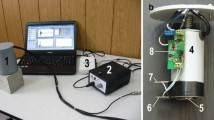Abstract
Regularities of changes in the parameters of acoustic and electromagnetic emission and of forced electric response from reinforced concrete under uniaxial compression have been studied. It has been established that the main diagnostic criteria of the onset of crack formation are the emergence of high-amplitude signals of acoustic and electromagnetic emission; considerable changes in the spectral composition of the electric signal; a decrease in the maximum coefficient of correlation between the spectra of signals registered at different stages of loading as compared with the spectrum of the signal prior to loading; and hopping shift of the frequency at which the maximum correlation coefficient is observed. On-line monitoring and periodic inspection can be used to assess the onset of crack-formation processes.
Similar content being viewed by others
References
Pendhari, S.S., Kant, T., and Desai, Y.M., Application of polymer composites in civil construction: a general review, Compos. Struct., 2008, vol. 84, no. 2, pp. 114–124.
Aggelis, D.G., Mpalaskas, A.C., and Matikas, T.E., Investigation of different fracture modes in cement-based materials by acoustic emission, Cem. Concr. Res., 2013, vol. 48, pp. 1–8.
Kyriazopoulos, A., Anastasiadis, C., Triantis, D., and Brown, C.J., Non-destructive evaluation of cementbased materials from pressure-stimulated electrical emission—preliminary results, Constr. Build. Mater., 2011, vol. 25, no. 4, pp. 1980–1990.
Molero, M., Aparicio, S., Al-Assadi, G., Casati, M.J., Hernandez, M.G., and Anaya, J.J., Evaluation of freezethaw damage in concrete by ultrasonic imaging, NDT&E Int., 2012, vol. 52, pp. 86–94.
Bui, D., Kodjo, S.A., Rivard, P., and Fournier, B., Evaluation of concrete distributed cracks by ultrasonic travel time shift under an external mechanical perturbation: study of indirect and semi-direct transmission configurations, J. Nondestr. Eval., 2013, vol. 32, no. 1, pp. 25–36.
Krzemien, K. and Hager, I., Post-fire assessment of mechanical properties of concrete with the use of the impact-echo method, Constr. Build. Mater., 2015, vol. 96, pp. 155–163.
Liu, P.-L. and Yeh, P.-L., Spectral tomography of concrete structures based on impact echo depth spectra, NDT&E Int., 2011, vol. 44, no. 8, pp. 692–702.
Tsai, Y.-T. and Zhu, J., Simulation and experiments of airborne zero-group-velocity Lamb waves in concrete plate, J. Nondestr. Eval., 2012, vol. 31, no. 4, pp. 373–382.
Algernon, D., Gräfe, B., Mielentz, F., Köhler, B., and Schubert, F., Imaging of the elastic wave propagation in concrete using scanning techniques: application for impact-echo and ultrasonic echo methods, J. Nondestr. Eval., 2008, vol. 27, no. 1, pp. 83–97.
Smyl, D., Rashetnia, R., Seppanen, A., and Pour-Ghaz, M., Can electrical resistance tomography be used for imaging unsaturated moisture flow in cement-based materials with discrete cracks?, Cem. Concr. Res., 2017, vol. 91, pp. 61–72.
Fursa, T.V., Savelev, A.V., and Osipov, K.Yu., Interrelation between electromagnetic response parameters and impact excitation characteristics in insulators, Tech. Phys., 2003, vol. 48, no. 11, pp. 1419–1423.
Osipov, K.Yu. and Fursa, T.V., Evaluating the depth of open cracks in concrete from parameters of electric response to elastic-impact excitation, Tech. Phys. Lett., 2013, vol. 39, no. 5, pp. 481–483.
Fursa, T.V., Dann, D.D., Petrov, M.V., and Korzenok, I.N., Effect of cyclic freezing-thawing on the parameters of electric response to elastic shock excitation of reinforced concrete, Russ. J. Nondestr. Test., 2016, vol. 52, no. 8, pp. 463–468.
Fursa, T.V., Mechanoelectrical transformations in cement-sand composites in the course of crack formation caused by freezing-thawing cycles, Tech. Phys. Lett., 2010, vol. 36, no. 4, pp. 348–350.
Fursa, T.V., Utsyn, G.E., Korzenok, I.N., Petrov, M.V., and Ruetov, Yu.A., Using electric response to mechanical impact for evaluating the durability of the GFRP-concrete bond during the freeze-thaw process, Compos. Part B: Eng., 2016, vol. 90, pp. 392–398.
Fursa, T.V., Utsyn, G.E., Dann, D.D., and Petrov, M.V., Development prospects for nondestructive testing of heterogeneous nonmetallic materials by the parameters of electrical response to a shock action, Russ. J. Nondestr. Test., 2017, vol. 53, no. 2, pp. 104–110.
Author information
Authors and Affiliations
Corresponding author
Additional information
Original Russian Text © T.V. Fursa, M.V. Petrov, D.D. Dann, A.E. Lykov, 2017, published in Defektoskopiya, 2017, No. 6, pp. 63–69.
Rights and permissions
About this article
Cite this article
Fursa, T.V., Petrov, M.V., Dann, D.D. et al. Developing an integrated technique to evaluate crack formation in reinforced concrete under uniaxial compression. Russ J Nondestruct Test 53, 457–463 (2017). https://doi.org/10.1134/S1061830917060079
Received:
Published:
Issue Date:
DOI: https://doi.org/10.1134/S1061830917060079



